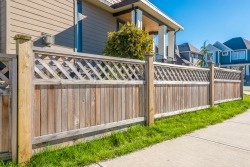 There are many reasons to install a fence – to keep family pets safe in the backyard, to keep unwanted visitors out of a farm, to increase outdoor privacy, to add curb appeal, and more. A fence can serve any of these purposes – as long as the right one is chosen and the project is done properly. There are hundreds of different styles to choose from, each with their own set of pros and cons, maintenance requirements, and price points.
There are many reasons to install a fence – to keep family pets safe in the backyard, to keep unwanted visitors out of a farm, to increase outdoor privacy, to add curb appeal, and more. A fence can serve any of these purposes – as long as the right one is chosen and the project is done properly. There are hundreds of different styles to choose from, each with their own set of pros and cons, maintenance requirements, and price points.
Even though each type of fence may be different, there are still some elements that make up every fence. Just like the anatomy of the human body, fence construction has many working parts that, when put together, make a fully functioning piece of equipment.
Cap
The cap, also called a post cap, covers the top of a fence post. Caps are typically used as decorative elements in chain link and vinyl fences, but they can also be used on other fence materials like cedar.
Rail
Rails are the horizontal support element to which fence boards or pickets are attached. Most fences have a top and bottom rail, and a middle rail may be added for additional support or decoration.
Post
Posts are vertical elements that help support the fence. Posts are the main part of the fence and serve as the fence’s backbone by keeping it stable during strong winds, rain, and other severe conditions. Fence posts are usually set a few feet apart.
There are several different types of posts on a fence including:
- Corner post: A post at the corner where two sections of the fence meet at a 90-degree angle
- End post: A post that marks the end of a fence line
- Terminal post: a load-bearing post for a line of fencing. It can be a corner, end, or gate post
- Gate post: The post to which a gate is attached via latches or hinges
Picket
Pickets are a vertical fence board that attaches to the rails of a fence. Pickets can be made of many different materials, but they are most frequently used on aluminum fences, vinyl fences, and cedar fences.
Baseboard
Baseboards are usually 2”x6” piece of wood that are attached to the posts and placed under the pickets. A fence’s baseboard acts as the first line of defense against rotting, moisture, and damage from lawn equipment. Baseboards can also work to stabilize the fence and keep it from falling over.
What Makes a Great Fence?
Not all fences are created equal. The most important elements of a great fence are high-quality materials and a top-notch installation. Although there are a lot of low-quality options on the market today, they won’t stand the test of time. Using higher quality materials for fence fasteners, and doing a great job on the installation will create an aesthetically pleasing fence that will stand the test of time.
Products such as SCRAIL® fasteners provide both speed and a very secure hold, resulting in lower labor costs overall. They can be installed up to eight times faster than bulk screws and can be removed and adjusted with ease, making them particularly well suited to temporary applications. In turn, they provide a fast return on your investment and a higher quality end product, making them an excellent choice for any wood or vinyl fencing project.
Interested in learning more about the fencing industry? Download our free whitepaper, Innovation in the Fencing Industry: A Fasco America® Whitepaper.
.svg.png)

